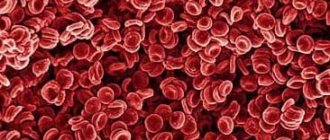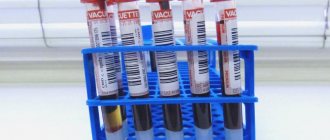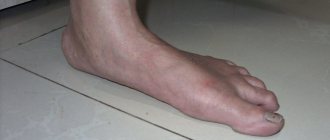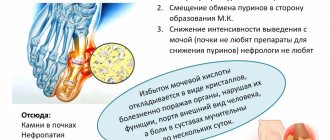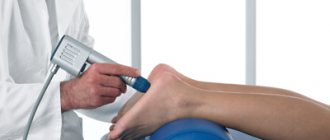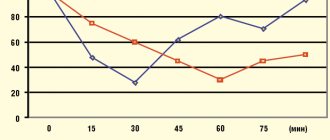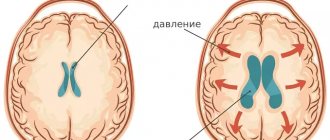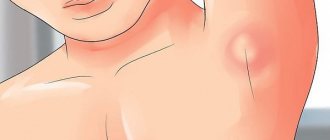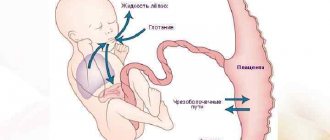Mechanism of formation of intervertebral hernia
The spine is designed to withstand loads. It supports and stabilizes the body in a standing position, providing complete freedom of movement. When lifting weights, uncomfortable positioning of the body, strong and stressful loads, it takes on the main effort. The load is especially severe when lifting heavy objects with outstretched arms. The heaviest load and, accordingly, wear falls on the lumbar region. When age-related or pathological changes begin in the body, tissues change structure and can no longer fully perform shock absorption functions. Under force, they can become deformed and crumble, which disrupts the functions of the spine and can disrupt the functioning of the entire body.
Features of anatomy
The entire spine is formed by more than 30 vertebrae of different sizes and is divided into 5 sections:
- cervical - formed by 7 vertebrae (C1–C2), which are the smallest and most mobile in the body;
- thoracic - formed by 12 vertebrae (Th1–Th12), least likely to be susceptible to degenerative-dystrophic changes;
- lumbar – consists of the 5 largest vertebrae (L1–L5), which bear the greatest load during physical work;
- sacral – has 3 vertebrae (S1–S3);
- coccyx – formed by 1–3 fused vertebrae.
Between all the vertebrae there are cartilaginous structures that provide shock absorption when walking and the natural flexibility of the spine. They are called intervertebral discs. Each disc has a pulpous nucleus pulposus and a tough outer shell called fibrous. It is protected on the sides by end plates.
How does a hernia appear?
The formation of protrusion occurs in several stages:
- Protrusion. The beginning of pathological changes. The fibrous ring becomes less elastic and can shift and become deformed.
- Partial loss of a section of the disc. This is the second stage in which tissue destruction can occur. This process is inevitably followed by displacement of the gel-like core of the disc.
- Prolapse. The nucleus emerges from the disc ring and begins to influence the nerve endings located nearby.
- Sequestration. The process by which a semi-liquid substance from the nucleus penetrates the cavity of the spinal column. This is accompanied by allergic reactions, nerve connections and blood flow in the tissues are disrupted. Due to constant pressure in an area that is not designed for it, there is a loss of sensitivity and the threat of paralysis.
If help is sought in a timely manner, when the process does not involve the nerves and spinal cord, conservative treatment is used and the patient can be completely cured.
Types by degree of protrusion
Another classification distinguishes hernias according to the degree of their extension beyond the intervertebral space and the integrity of the fibrous ring. There are such types - protrusion, prolapse, extrusion, sequestration.
Protrusion
A type of minor spinal hernia, when only the internal fibers of the fibrous ring are damaged, the ring itself does not rupture. The reason is deformation and dehydration of the intervertebral disc, which reduces its elasticity. Cracks appear in the ring, and the fixation of the vertebrae with each other deteriorates.
Bulging occurs under vertical loads. Therefore, if the patient was lying down during the examination, the defect may not be noticed. The formation often occurs in the lumbar spine, less often in the neck and chest. The compression of the nerve endings disappears quickly. The nature of the pain depends on the location of the protrusion:
- thoracic region
- the heart, lungs, and other organs inside the sternum ache; - lumbar zone
- discomfort in the back, numbness in the legs, groin area; - cervical spine
– neck pain, decreased blood pressure, headache, tinnitus.
Prolapse
Prolapse is a medium-sized hernia of the spine, which is characterized by partial release of the nucleus into the spinal canal. The ring may simply stretch too much or tear. The nucleus compresses the nerve roots, causing inflammation and swelling of the tissue.
The appearance of a protrusion is accompanied by chronic pain, impaired sensitivity in the lower back, neck, legs and arms. Discomfort intensifies with sudden movements (coughing, sneezing), and can put a person to bed for several days.
Prolapse usually appears in the lower back. The main reason is spinal injury due to heavy lifting, sudden straightening and turning, working in an awkward position, hypothermia, and stress.
Extrusion
Extrusion is a hernia in which the fibrous ring is torn, but the longitudinal ligament remains intact. Discomfort appears if the nucleus pulposus touches the nerve roots.
Pain symptoms may vary, depending on the size and displacement of the protrusion. With a strong shift, a dull spasm occurs in the neck, which moves to the head and shoulder. Possible numbness, tingling, and loss of skin sensitivity. With breast extrusion, the heart, ribs, stomach, and intestines hurt. When the lumbar region is affected, problems appear in the lower back, groin, and legs. The development of pathology is fraught with impaired urination and erection in men.
Protrusion, prolapse, extrusion, severstration - types of hernias according to the degree of their extension beyond the intervertebral space
Severstration
Sequestration is a severe form of hernia, which is characterized by the formation of a sequester - the prolapse of the nucleus or part of the disc into the spinal canal. Due to rupture of the longitudinal ligament, the nucleus pulposus is completely or partially separated from the disc. It falls into the canal, squeezing the nerves. The mass may remain in place or migrate up or down, simulating a herniation of another vertebra.
The diagnosis is usually made in older people. A striking symptom is lumbago in the back, which radiates to the legs or arms, followed by numbness, sometimes paralysis.
How does a hernia manifest?
At the very beginning of the development of the pathological process, the patient does not feel serious pain, symptoms are few. The more tissue protrudes, the more the patient feels it. There are three groups of symptoms for intervertebral hernia:
- The main symptom of a herniated disc is pain. At first it is not sharp, may be aching, and go away with a change in body position. The more serious the stage of the process, the stronger the pain. Shooting sensations appear, it is painful for the patient to turn the body, the sensations intensify with physical activity.
- Spinal syndrome. Constant pain causes spasms in the lower back muscles. The patient cannot move fully and is forced to tilt the body in order to relieve some of the load and reduce pain.
- Damage and death of nerve roots due to constant compression. The compression that occurs due to tissue protrusion constantly affects the nerve fibers. This disrupts blood flow, their functions, and later death occurs altogether. The manifestations of this process are: weakness, decreased tone, loss of sensitivity, the appearance of body asymmetry, decreased sensitivity and tone of the skin.
If the protrusion occurs in the posterior direction, any physical work is highly likely to cause severe compression and paralysis.
Physical therapy for spinal hernia using Bubnovsky’s method
The main distinguishing feature of Bubnovsky’s exercises from conventional physical therapy is the load on the muscles through pain. In his opinion, it is necessary to fight pathology by overcoming the pain threshold, since it is this symptom that limits movement and causes muscle atrophy. Classes using the Bubnovsky system prevent the development of a hernia and reduce its size. This method is also called kinesitherapy.
The effectiveness of physical therapy according to the Bubnovsky system largely depends on the fulfillment of the following requirements. Necessary:
- Maintain proper breathing.
- Stretch your muscles and spine.
- Complete absence of drug treatment.
- Strengthen the muscle frame.
The impact should be on all muscles of the body, and especially on those that are subject to stress in everyday life.
The basic complex includes the following exercises:
- In yoga it is called “Cat”. Get on all fours, focusing on your palms and knees. Inhale and arch your back. Exhaling, bend in the opposite direction. Hold the pose for two to three seconds and return to the starting position. Repeat 10–20 times. Perform movements smoothly and slowly.
- Walking on your buttocks. Sit on the floor, keep your legs and back straight, arms at chest level. Walk forward using your butt muscles and come back. Perform 8–10 reps.
- "Bike". Starting position – lying on your back. Bend both legs at the knees and alternate your feet in a circle in the air (in other words, move as if you were riding a bicycle). Do the exercise for one minute.
- Side bends. Stand straight, feet shoulder-width apart, hands on your waist. As you inhale, bend to the right (do not bend your back), while exhaling, return to the starting position. Repeat the movement to the left. Perform the exercise ten times on each side.
- "Bridge". Lie on your back. Inhale deeply and, as you exhale, bend, rising on your arms and legs to the maximum possible height. Hold the pose for three to five seconds. Do five reps.
Nowadays, you no longer have to spend a lot of time performing complex and unpleasant procedures at home. It is much easier to seek help from real professionals - the Veronika Herba beauty and health center, equipped with effective and modern equipment.
Why clients choose Veronika Herba Beauty and Health Center:
- This is a beauty center where you can take care of yourself at a reasonable cost, while your face and/or body will be treated not by an ordinary cosmetologist, but by one of the best dermatologists in Moscow. This is a completely different, higher level of service!
- You can receive qualified help at any time convenient for you. The beauty center is open from 9:00 to 21:00, seven days a week. The main thing is to agree with your doctor in advance on the date and time of your appointment.
Sign up for a consultation with a specialist by phone +7 (495) 085-15-13
, and you will see for yourself!
Manifestations depending on the location of the hernia
The characteristics of a hernia are determined by its location. In this area, the nerve roots are pinched and a characteristic clinical picture occurs. The nerve that is pinched during the formation of the lumbar protrusion of the spine runs along the inner surface of the leg from the hip to the ankle. The pain is not necessarily localized along the entire length; it can be reflected in the leg, foot, buttock, or outer side of the thigh. The lower back may also hurt at one point. As the situation develops, the pain may move lower - to the lower leg, heel and toes. In intensity, it can be a constant aching pain or lumbago that occurs when moving.
Basically, the pain becomes more intense with prolonged walking, standing, turning the body, and bending. It is also painful to lift your leg, do a number of exercises, and also drive on uneven roads.
At the beginning of the development of a hernia, pain can be relieved by lying down, bending one leg at the chest. This will help relieve tension and pressure on the nerve endings. In a more complex situation, this method will not help. Movements are constrained, their amplitude is greatly reduced, and the leg gets tired.
Basically, the patient feels compression of the spinal cord as tingling, burning, and numbness. It dulls the pain. The main symptom that the specialist will pay attention to during the examination is muscle tension on the side of the back, painful when pressed.
Diagnostics
Diagnosis of spinal hernia is carried out on the basis of a survey, examination and hardware methods (X-ray, MRI, CT).
During the interview, the doctor asks the patient about the nature of the symptoms, the time and circumstances of their occurrence, and lifestyle.
During the examination, the doctor palpates the back along the spine. Using pinpoint pressure, he finds centers of muscle tension (trigger points), determines the location and boundaries of spasms, the location of pinched nerve roots and disc damage.
Next, the doctor conducts a series of tests, examining tendon reflexes, muscle strength of the legs and arms (resistance to stress).
The main hardware method for diagnosing intervertebral herniation is magnetic resonance imaging (MRI), which has significant advantages over x-rays.
Important! X-ray shows only bone tissue well. In the image you can see the convergence of the vertebrae and, based on this, determine the stage of osteochondrosis.
MRI shows connective tissue better. On the tomogram, the doctor clearly sees the direction and size of the prolapse, the type of hernia (sequestrated or not), the presence or absence of spinal stenosis, and its risk.
It is the tomogram obtained using MRI that serves as the basis for drawing up an individual treatment plan.
Establishing diagnosis
The diagnosis is made after examination and examination of the patient. First of all, instrumental diagnostics are carried out to help determine whether the tendon reflexes are normal. The patient is asked to raise his straightened leg. Tests are also carried out for sensitivity to vibration, the ability to sense temperature and pain. If there is a hernia, there will be certain manifestations:
- The doctor will determine the sensitivity disorder.
- The patient's movement biomechanics will be changed.
- Tendon reflexes will deviate from normal.
Also, to diagnose protrusion, CT or MRI diagnostics of the spine is performed. These studies will help not only visualize the hernia, but also determine the condition of the surrounding tissues and diagnose narrowing of the spinal canal, if any. If indicated, contrast myelography may be prescribed. After the examination, the degree of pathological changes can be determined and adequate treatment can be prescribed. If the nerves are not affected, the patient complains only of pain, conservative therapy is used.
Treatment prognosis
The effectiveness of treatment, both conservative and surgical, directly depends on how accurately the patient follows medical recommendations. Also, the likelihood of relapse depends on the nature of the operation performed. With complete removal of the disc in one way or another, there is no risk of recurrence of the hernia in the same place, but it can form in adjacent spinal motion segments.
On average, the relapse rate after surgical treatment of hernias is 11.5%. But most often they are formed in other PDS.
Why is a lumbar hernia dangerous?
Any hernia brings not only pain, but also a serious risk of disruption of the body and paralysis. Vertebral protrusion in the lumbar region has a number of dangerous accompanying manifestations:
- Blood circulation in the pelvis is disrupted, due to which the organs do not receive proper nutrition. This provokes problems with the excretory system and disruption of the internal genital organs.
- The spine is curved due to muscle tone. This causes compression of internal organs and can provoke other pathologies not directly related to the spine.
- Sensitivity decreases, numbness and limited body mobility are observed.
- Shooting appears - severe sharp pain during physical activity or movement.
- Knee reflexes may disappear, and mobility of the ankle and foot may change.
- The most serious consequence is paralysis.
Which doctor should I contact?
Spinal diseases are treated by vertebrologists and neurologists, who often also work as chiropractors. They should be contacted if the slightest of the above-described deviations occurs. They are also the ones who interpret MRI, CT and X-ray images.
But due to their own workload, and often laziness, when symptoms of hernias and, in particular, back pain occur, people delay seeing a doctor. Painkillers in the form of tablets or ointments are often used on their own. But they only temporarily eliminate the symptom that is key to the disease.
This allows you to continue to lead your usual lifestyle, but has a negative impact on the prognosis, as the protrusion continues to increase. Therefore, over time, the pain syndrome intensifies, then neurological disorders in the form of numbness of the limbs or even paralysis join it, and internal organs corresponding to the level of damage also suffer.
Often in such situations people say that they are “falling apart.” And the reason lies in the intervertebral hernia. Therefore, in order to prevent this from happening, you should consult a doctor if the slightest manifestations of the disease appear. This specialist will be able to choose the right treatment tactics and assess the prospects for conservative therapy. Indeed, in advanced cases, the situation can only be corrected through surgery.
Prolonged ignoring of the problem can lead to the development of severe complications, including:
- spinal canal stenosis;
- disorders of the pelvic organs, up to loss of control over urination and defecation, as well as persistent erectile dysfunction;
- complete paralysis of the limbs.
Therefore, we recommend not to delay and contact a vertebrologist, chiropractor or neurologist as early as possible. Otherwise, conservative therapy will not bring results and the patient will have to muster the courage, as well as material resources, to perform a neurosurgical operation. Moreover, no neurosurgeon can give a 100% guarantee that it will be effective.
The specialist will prescribe the necessary studies, based on the results of which he will select the correct treatment tactics, taking into account the nature of the existing changes, the size of the hernia, its location and the clinical picture.
Operation
Radical intervention is used when it is necessary to free the spinal cord and nerves from the pressure of protruding tissues. The most popular methods are:
- Endoscopy is an operation through an incision in the spine using a probe. A camera and instruments are inserted through a small hole, and displaced tissue is removed.
- Disc endoprosthetics. Damaged elements are removed. A prosthetic structure is installed in their place.
- Percutaneous discectomy. Access is made through a puncture, the deformed core is removed and replaced with a special compound.
- Laser reconstruction – the hernia is removed by evaporating moisture from the tissue.
Exercise technique
The best time for exercise therapy is morning or evening. Exercises should be done smoothly, slowly, after warming up.
When performing exercise therapy, pay attention to your body’s reaction. If severe discomfort, pain in the heart, or back occurs, the training should be stopped or the load reduced.
You need to exercise daily, unless your doctor says otherwise. For therapeutic exercises to bring results, the load must be increased slowly: start with 3-4 repetitions, after a week do ten (no more).
At first, exercise therapy should be performed under the supervision of a doctor. He will show you how to practice correctly and correct any inaccuracies. He will tell you when to increase the number of repetitions and the load.
Preventive measures
Spinal herniation can be prevented. There are a few simple rules for this:
- Nutrition and weight control. Excess weight increases the load on the spine.
- Rejection of bad habits.
- Regular physical activity - morning exercises, warm-up during sedentary work.
- Sleep on a hard mattress, choose the right pillow.
- Preventive examinations with a doctor, timely seeking medical help if alarming symptoms appear.
By contacting a neurologist at the Central Clinical Hospital of the Russian Academy of Sciences in a timely manner, you can avoid complications and return to a normal lifestyle as soon as possible.
Prevention
To reduce the likelihood of a hernia forming or reoccurring, it is important to make lifestyle changes. First of all you should:
- stop smoking and minimize the amount of alcohol consumed;
- do exercise therapy and stretching exercises daily;
- undergo a course of manual therapy twice a year;
- avoid stress and change your attitude towards stressful situations;
- sleep at least 7–8 hours;
- wear high-heeled shoes no more than 2 hours a day;
- visit the pool twice a week;
- balance your diet, give up unhealthy foods and adhere to a normal drinking regime (at least 1.5 liters of water per day);
- take vitamins, especially group B and unsaturated fatty acids (Omega-3).
FAQ
Will exercise therapy help you recover faster after a hernia removal?
Yes, it will help. The main thing is to strictly follow all the doctor’s advice, do not rush, and do not increase the load ahead of time.
Is it possible to do exercise therapy for Schmorl's hernia?
Yes. Exercise therapy can be done for any type of hernia, when the acute pain subsides. The main thing is to choose the right set of exercises. If you have a Schmorl's hernia, you definitely need to pump up and strengthen the muscles, especially the back and abdomen. It is important to remember: weight bearing is contraindicated.
Is it possible to do exercise therapy for a sequestered hernia?
It is possible, but we must proceed from the fact that exercise therapy cannot be done during the acute phase. When the pain subsides, light exercise is allowed after consulting a doctor. Water gymnastics gives a good effect.
Themes
Intervertebral hernia, Spine, Pain, Treatment without surgery Date of publication: 11/12/2020 Date of update: 03/16/2021
Reader rating
Rating: 5 / 5 (3)

